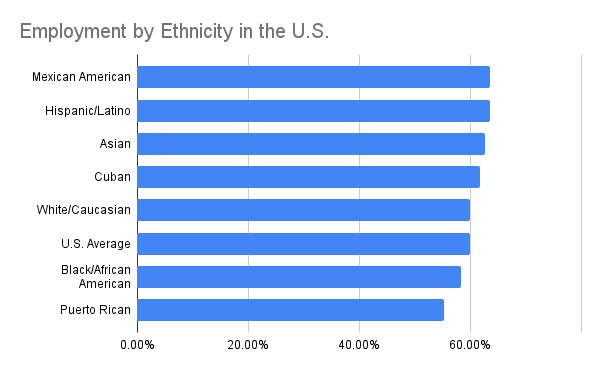10.4 Diversity in the Workplace
Adapted by Stephen Skripak with Ron Poff
The makeup of the US workforce has changed dramatically over the past 50 years. In the 1950s, more than 60 percent was composed of white males.[1]Today’s workforce reflects the broad range of differences in the population—differences in gender, race, ethnicity, age, physical ability, religion, education, and lifestyle. As you can see in Figure 10.5, around 62.7 percent of the Asian community was employed in 2022 while the lowest employment rate was found among Puerto Ricans, at 55.3 percent, and the highest employment rate was found among Mexican-Americans, at 63.6 percent. Combined, 60 percent of the average U.S. citizens were employed in 2022. [2]

Most companies today strive for diverse workforces. HR managers work hard to recruit, hire, develop, and retain a diverse workforce. In part, these efforts are motivated by legal concerns: discrimination in recruiting, hiring, advancement, and firing is illegal under federal law and is prosecuted by the EEOC.[3] Companies that violate anti-discrimination laws are subject to severe financial penalties and also risk reputation damage. In November 2004, for example, the EEOC charged that recruiting policies at Abercrombie & Fitch, a national chain of retail clothing stores, had discriminated against minority and female job applicants between 1999 and 2004. The EEOC alleged that A&F had hired a disproportionate number of white salespeople, placed minorities and women in less visible positions, and promoted a virtually all-white image in its marketing efforts. Six days after the EEOC filed a lawsuit, the company settled the case at a cost of $50 million, but the negative publicity may hamper both recruitment and sales for some time.[4]

Reasons for building a diverse workforce go well beyond mere compliance with legal standards. It even goes beyond commitment to ethical standards. It’s good business. People with diverse backgrounds bring fresh points of view that can be invaluable in generating ideas and solving problems. In addition, they can be the key to connecting with an ethnically diverse customer base. If a large percentage of your customers are Hispanic, it might make sense to have a Hispanic marketing manager. In short, capitalizing on the benefits of a diverse workforce means that employers should view differences as assets rather than liabilities.
Statista and Forbes Magazine published ‘America’s Best Employers for Diversity 2022’ and included the following:

Key Takeaways
- Attracting a diverse workforce goes beyond legal compliance and ethical commitments, because a diverse group of employees can offer perspectives that may be valuable in generating ideas, solving problems, and connecting with an ethnically diverse customer base.
- Judith Lindenberger and Marian Stoltz-Loike (2015). “Diversity in the Workplace.” Zeromillion.com. Retrieved from: http://www.zeromillion.com/econ/workplace-diversity.html ↵
- Statista (2022). “Employment Rate in the United States by Ethnicity 2022” Retrieved from: https://www.statista.com/statistics/237939/us-employment-rates-by-ethnicity/ ↵
- U.S. Equal Employment Opportunity Commission (2009). “Federal Laws Prohibiting Job Discrimination: Questions and Answers.” Retrieved from: http://www.eeoc.gov/facts/qanda.html ↵
- U.S. Equal Employment Opportunity Commission (2004). “EEOC Agrees to Landmark Resolution of Discrimination Case Against Abercrombie & Fitch.” Retrieved from: https://www.eeoc.gov/eeoc/newsroom/release/11-18-04.cfm ↵

